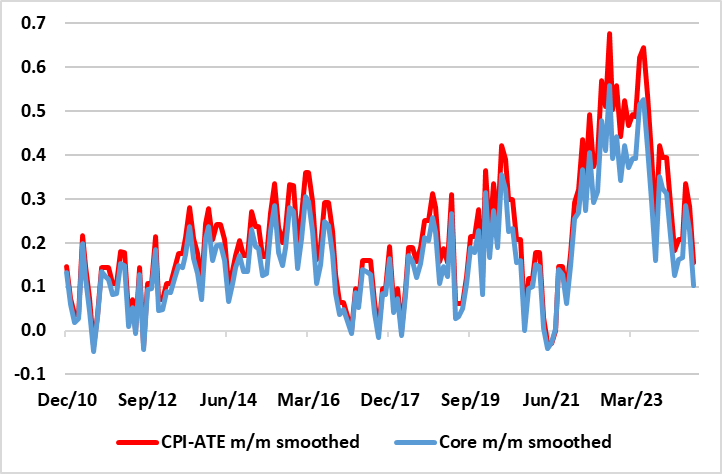Norges Bank Review: Head in the Sand?
Surprising few, and with no mention of recent stock market gyrations, the Norges Bank is kept its policy rate at 4.5% for a fifth successive meeting this month, the last hike to the current 4.5% policy rate occurring last December. But amid what have been softer than (Norges Bank) expectations for CPI data of late, as well as softer real economy numbers the question was whether the Board would tone down its hawkish leanings and perhaps depart from its recent stress of ‘policy to stay on hold for some time ahead’. Last time (in June) this was backed up formally with an updated policy outlook that foresaw no rate cut until early-2025, some three months later than considered previously. With no formal projections due until the September Board meeting, there was no such change in its thinking, instead very much putting the (weak) krone at the centre of its thinking. This to us seems very puzzling as a) this hawkish policy leaning has failed to bolster the currency and b) the weak currency has not prevented a marked fall in inflation that in adjusted m/m terms is not only well below target (Figure 1) but back at (if not below) rates seen in the decade before the pandemic. We still think continued inflation weakness in coming months as weaker profit margins offset labor costs issues will deliver at least one cut by end-year and maybe over 100 bp in 2025!
Figure 1: Core Adjusted Inflation Below Target

Source: Stats Norway, CE, smoothed is 3-mth mov avg
This Norges Bank decision was the first DM central bank meeting since the onset of the recent stock market correction. It merited no obvert attention. Admittedly, the Board noted uncertainty about future economic developments, but this was more a result based around the balance of risks stemming from developments in the krone exchange rate and the potential implications for inflation. Possibly advertising that a change of thinking may be under consideration, the Board highlighted that it will have received more information about economic developments ahead of its next monetary policy meeting in September, when new forecasts will be presented.
We think any such change in thinking is long overdue. They say the definition of madness is doing the same thing repeatedly, each time expecting the same result. In this regard, since the last hike nine months ago, a hawkish tone of keeping rates high for some time has repeatedly failed to unwind krone weakness, this despite the added bonus of a substantial Norwegian current account surplus. We are not sure what is driving the krone’s softness, but we also would say that neither do the Norges Bank, not least as high (and threated persistent) interest rates have not helped.
The Board could argue that the currency would be even weaker without its policy stance – but this is impossible to ascertain as there is no counterfactual. What is clear is that the Norges Bank has an inflation remit, not a currency one. Yes, the currency is an ingredient into the inflation picture, albeit one that affects more the price level than the rate of price changes – other factors determine the latter more. Regardless, the (weak) krone has not prevented imported inflation falling – now at 1.5%, less than a quarter of the rate some 12 month ago.
Notably this has helped drive inflation down on a broad basis so that the targeted measure CPI-ATE (ie the CPI adjusted for tax changes and excluding energy products) has more than halved in the last year to 3.3%. Admittedly, this is still above the 2% target and where Norges Bank projections see it remaining (well) above even out to 2027. We think the Norges Bank are very wrong on this, we noting that those projections envisage CPI-ATE inflation this quarter to be well over ppt higher than the July outcome of 3.3%. But even this is of secondary importance to just how much recent price dynamics have weakened, something that largely backward looking y/y rates are masking.
Indeed, as for inflation, we think the Board has underestimated the extent to which it has retreated of late on an underlying basis, this very much evident in seasonally adjusted data, for various core measures; we have computed a core measure in which food is excluded from the familiar CPI-ATE figure. Both this core and the CPI-ATE measures show recent seasonally adjusted m/m dynamics now to be running at pace nearer 0.1% per month, ie consistent with the 2% target being undershot (Figure 1) and actually back (if not below) the average rate in the ‘lowflation’ decade before the pandemic. And this is in spite of the impact of rental inflation (around 17% of the CPI) running still at over 4% y/y, implying headline inflation ex rents now at 2.5%. This begs the question whether Norges Bank policy is actually buttressing inflation as higher interest rates therefore mean higher inflation as rents are largely being driven by (high) mortgage rates. Moreover, the resilience in rents may help explain the puzzling manner in which consumer confidence has developed of late, ie where households perceive a better financial position but are not willing to consider spending more.
Against this backdrop we think the Norges Bank will advertise a change in thinking in its Sep 19 policy verdict, aided by updated projections. After all, with policy at 4.5%, the Board has ample room to ease and still have a monetary stance that would remain restrictive. Indeed, we would not rule out an easing at that juncture. All of which reflects a marked irony: among DM central banks the one with the lowest underlying inflation backdrop is the one most resolutely refraining from actual or advertised rate cuts.